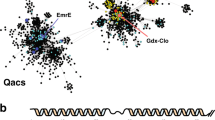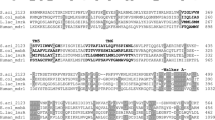Abstract
Small Multidrug Resistance (SMR) transporters are small homo- or hetero-dimers that confer resistance to multiple toxic compounds by exchanging substrate with protons. They reside in the inner membrane of bacteria and in halophilic and methanogenic archaea and because many of their substrates are routinely used as antibiotics and antiseptics, they have been associated with the phenomenon of multidrug resistance. EmrE, the most studied SMR member, has presented biochemists with unusual surprises regarding its topology and raised an interesting controversy since structural information was in an apparent conflict with biochemical data. One of the reasons for the controversy was the assumption that, to ensure proper function, membrane proteins must be inserted by a mechanism that warrants a unique topology. As it turns out, EmrE and other SMR transporters display a remarkable plasticity regarding topology in the membrane, interaction between subunits, and interaction with substrates. This plasticity implies a high evolvability of these proteins and, as a consequence, a lack of commitment that facilitates acquisition of new functions and topologies. Because of this high evolvability, we suggest that SMRs are living fossils at an evolutionary junction. Study of their properties provides a wonderful glimpse at the evolution and mechanism of ion-coupled transporters.
Access this chapter
Tax calculation will be finalised at checkout
Purchases are for personal use only
Similar content being viewed by others
References
Adam Y, Tayer N, Rotem D, Schreiber G, Schuldiner S (2007) The fast release of sticky protons: Kinetics of substrate binding and proton release in a multidrug transporter. Proc Natl Acad Sci U S A 104(46):17989–17994. doi:10.1073/pnas.0704425104
Arkin IT, Xu H, Jensen MO, Arbely E, Bennett ER, Bowers KJ, Chow E, Dror RO, Eastwood MP, Flitman-Tene R, Gregersen BA, Klepeis JL, Kolossvary I, Shan Y, Shaw DE (2007) Mechanism of Na+/H + antiporting. Science 317(5839):799–803. doi:10.1126/science.1142824
Bamber L, Harding M, Monne M, Slotboom DJ, Kunji ER (2007) The yeast mitochondrial ADP/ATP carrier functions as a monomer in mitochondrial membranes. Proc Natl Acad Sci U S A 104(26):10830–10834, doi:0703969104 [pii]10.1073/pnas.0703969104
Bay DC, Turner RJ (2009) Diversity and evolution of the small multidrug resistance protein family. BMC Evol Biol 9:140, doi:1471-2148-9-140 [pii] 10.1186/1471-2148-9-140
Bay DC, Rommens KL, Turner RJ (2008) Small multidrug resistance proteins: A multidrug transporter family that continues to grow. Biochim Biophys Acta 1778:1814–1838
Brill S, Falk OS, Schuldiner S (2012) Transforming a drug/H + antiporter into a polyamine importer by a single mutation. Proc Natl Acad Sci U S A 109:16894–16899. doi:10.1073/pnas.1211831109
Chang G, Roth CB, Reyes CL, Pornillos O, Chen Y-J, Chen AP (2006) Retraction. Science 314(5807):1875. doi:10.1126/science. 314.5807.1875b
Chen YJ, Pornillos O, Lieu S, Ma C, Chen AP, Chang G (2007) X-ray structure of EmrE supports dual topology model. Proc Natl Acad Sci U S A 104(48):18999–19004
Eicher T, Brandstatter L, Pos KM (2009) Structural and functional aspects of the multidrug efflux pump AcrB. Biol Chem 390(8):693–699. doi:10.1515/BC.2009.090
Fleishman SJ, Harrington SE, Enosh A, Halperin D, Tate CG, Ben-Tal N (2006) Quasi-symmetry in the cryo-EM structure of EmrE provides the key to modeling its transmembrane domain. J Mol Biol 364(1):54–67
Fluman N, Ryan CM, Whitelegge JP, Bibi E (2012) Dissection of mechanistic principles of a secondary multidrug efflux protein. Mol Cell 47(5):777–787. doi:10.1016/j.molcel.2012.06.018
Forrest LR, Rudnick G (2009) The rocking bundle: a mechanism for ion-coupled solute flux by symmetrical transporters. Physiology (Bethesda) 24:377–386, doi:24/6/377 [pii] 10.1152/physiol.00030.2009
Fujiyoshi Y, Mitsuoka K, de Groot BL, Philippsen A, Grubmüller H, Agre P, Engel A (2002) Structure and function of water channels. Curr Opin Struct Biol 12(4):509–515
Geertsma ER, Duurkens RH, Poolman B (2005) Functional Interactions between the subunits of the lactose transporter from Streptococcus thermophilus. J Mol Biol 350(1):102–111
Godsey MH, Zheleznova Heldwein EE, Brennan RG (2002) Structural biology of bacterial multidrug resistance gene regulators. J Biol Chem 277(43):40169–40172
Grinius L, Goldberg E (1994) Bacterial multidrug resistance is due to a single membrane protein which functions as a drug pump. J Biol Chem 269:29998–30004
Guan L, Kaback HR (2004) Binding affinity of lactose permease is not altered by the H + electrochemical gradient. Proc Natl Acad Sci 101(33):12148–12152. doi:10.1073/pnas.0404936101
Gutman N, Steiner-Mordoch S, Schuldiner S (2003) An amino acid cluster around the essential Glu-14 is part of the substrate and proton binding domain of EmrE, a multidrug transporter from Escherichia coli. J Biol Chem 278:16082–16087
Herz K, Rimon A, Jeschke G, Padan E (2009) Beta-sheet-dependent dimerization is essential for the stability of NhaA Na+/H + antiporter. J Biol Chem 284(10):6337–6347. doi:10.1074/jbc.M807720200
Kolbusz MA, Slotboom DJ, Lolkema JS (2013) Genomic distribution of the small multidrug resistance protein EmrE over 29 Escherichia coli strains reveals two forms of the protein. FEBS J 280(1):244–255. doi:10.1111/febs.12065
Lanyi JK (2004) Bacteriorhodopsin. Annu Rev Physiol 66(1):665–688, doi:10.1146/annurev.physiol.66.032102.150049
Mager T, Rimon A, Padan E, Fendler K (2011) Transport mechanism and pH regulation of the Na+/H + antiporter NhaA from Escherichia coli: An electrophysiological study. J Biol Chem 286:23570–23581, doi:M111.230235 [pii]10.1074/jbc.M111.230235
McHaourab HS, Mishra S, Koteiche HA, Amadi SH (2008) Role of sequence bias in the topology of the multidrug transporter EmrE. Biochemistry 47(31):7980–7982. doi:10.1021/bi800628d
Miller C, Nguitragool W (2009) A provisional transport mechanism for a chloride channel-type Cl-/H + exchanger. Philos Trans R Soc Lond B Biol Sci 364(1514):175–180, doi:Q311319160335168 [pii] 10.1098/rstb.2008.0138
Murakami S, Nakashima R, Yamashita E, Matsumoto T, Yamaguchi A (2006) Crystal structures of a multidrug transporter reveal a functionally rotating mechanism. Nature 443(7108):173–179
Muth TR, Schuldiner S (2000) A membrane-embedded glutamate is required for ligand binding to the multidrug transporter EmrE. EMBO J 19(2):234–240
Nasie I, Steiner-Mordoch S, Gold A, Schuldiner S (2010) Topologically random insertion of EmrE supports a pathway for evolution of inverted repeats in ion-coupled transporters. J Biol Chem 285(20):15234–15244, doi:M110.108746 [pii]10.1074/jbc.M110.108746
Ninio S, Rotem D, Schuldiner S (2001) Functional analysis of novel multidrug transporters from human pathogens. J Biol Chem 276(51):48250–48256
Padan E, Zilberstein D, Schuldiner S (1981) pH Homeostasis in Bacteria. Biochim Biophys Acta 650:151–166
Padan E, Kozachkov L, Herz K, Rimon A (2009) NhaA crystal structure: functional-structural insights. J Exp Biol 212(Pt 11):1593–1603. doi:10.1242/jeb.026708
Perez C, Khafizov K, Forrest LR, Kramer R, Ziegler C (2011) The role of trimerization in the osmoregulated betaine transporter BetP. EMBO Rep 12(8):804–810. doi:10.1038/embor.2011.102
Pornillos O, Chen YJ, Chen AP, Chang G (2005) X-ray structure of the EmrE multidrug transporter in complex with a substrate. Science 310(5756):1950–1953
Rapp M, Granseth E, Seppala S, von Heijne G (2006) Identification and evolution of dual-topology membrane proteins. Nat Struct Mol Biol 13(2):112–116
Rapp M, Seppala S, Granseth E, von Heijne G (2007) Emulating membrane protein evolution by rational design. Science 315(5816):1282–1284
Rotem D, Schuldiner S (2004) EmrE, a multidrug transporter from Escherichia coli, transports monovalent and divalent substrates with the same stoichiometry. J Biol Chem 279:48787–48793
Rotem D, Sal-man N, Schuldiner S (2001) In vitro monomer swapping in EmrE, a multidrug transporter from Escherichia coli, reveals that the oligomer is the functional unit. J Biol Chem 276(51):48243–48249
Schuldiner S (2007) When biochemistry meets structural biology: the cautionary tale of EmrE. Trends Biochem Sci 32(6):252–258
Schuldiner S (2009) EmrE, a model for studying evolution and mechanism of ion-coupled transporters. Biochim Biophys Acta 1794:748–762, doi:S1570-9639(08)00398-1 [pii] 10.1016/j.bbapap.2008.12.018
Schuldiner S (2012) Undecided membrane proteins insert in random topologies. Up, down and sideways: it does not really matter. Trends Biochem Sci 37(6):215–219. doi:10.1016/j.tibs.2012.02.006
Seeger MA, Schiefner A, Eicher T, Verrey F, Diederichs K, Pos KM (2006) Structural asymmetry of AcrB trimer suggests a peristaltic pump mechanism. Science 313(5791):1295–1298
Seeger MA, von Ballmoos C, Verrey F, Pos KM (2009) Crucial role of Asp408 in the proton translocation pathway of multidrug transporter AcrB: evidence from site-directed mutagenesis and carbodiimide labeling. Biochemistry 48(25):5801–5812. doi:10.1021/bi900446j
Sharoni M, Steiner-Mordoch S, Schuldiner S (2005) Exploring the binding domain of EmrE, the smallest multidrug transporter. J Biol Chem 280(38):32849–32855
Soskine M, Steiner-Mordoch S, Schuldiner S (2002) Crosslinking of membrane-embedded cysteines reveals contact points in the EmrE oligomer. Proc Natl Acad Sci U S A 99(19):12043–12048
Soskine M, Adam Y, Schuldiner S (2004) Direct evidence for substrate induced proton release in detergent solubilized EmrE, a multidrug transporter. J Biol Chem 279:9951–9955
Soskine M, Mark S, Tayer N, Mizrachi R, Schuldiner S (2006) On parallel and antiparallel topology of an homodimeric multidrug transporter. J Biol Chem 281(47):36205–36212
Steiner-Mordoch S, Soskine M, Solomon D, Rotem D, Gold A, Yechieli M, Adam Y, Schuldiner S (2008) Parallel topology of genetically fused EmrE homodimers. EMBO J 27(1):17–26
Taglicht D, Padan E, Schuldiner S (1993) Proton-sodium stoichiometry of NhaA, an electrogenic antiporter from Escherichia coli. J Biol Chem 268:5382–5387
Tanaka Y, Hipolito CJ, Maturana AD, Ito K, Kuroda T, Higuchi T, Katoh T, Kato HE, Hattori M, Kumazaki K, Tsukazaki T, Ishitani R, Suga H, Nureki O (2013) Structural basis for the drug extrusion mechanism by a MATE multidrug transporter. Nature 496(7444):247–251. doi:10.1038/nature12014
Ubarretxena-Belandia I, Baldwin JM, Schuldiner S, Tate CG (2003) Three-dimensional structure of the bacterial multidrug transporter EmrE shows it is an asymmetric homodimer. EMBO J 22(23):6175–6181
Veenhoff LM, Heuberger EHML, Poolman B (2002) Quaternary structure and function of transport proteins. Trends Biochem Sci 27(5):242–249
Weinglass AB, Soskine M, Vazquez-Ibar JL, Whitelegge JP, Faull KF, Kaback HR, Schuldiner S (2005) Exploring the role of a unique carboxyl residue in EmrE by mass spectrometry. J Biol Chem 280(9):7487–7492
Williams KA, Geldmacher-Kaufer U, Padan E, Schuldiner S, Kuhlbrandt W (1999) Projection structure of NhaA, a secondary transporter from Escherichia coli, at 4.0 A resolution. EMBO J 18(13):3558–3563
Yernool D, Boudker O, Jin Y, Gouaux E (2004) Structure of a glutamate transporter homologue from Pyrococcus horikoshii. Nature 431(7010):811–818
Yerushalmi H, Schuldiner S (2000a) A common binding site for substrates and protons in EmrE, an ion-coupled multidrug transporter. FEBS Lett 476:93–97
Yerushalmi H, Schuldiner S (2000b) An Essential Glutamyl Residue in EmrE, a Multidrug Antiporter from Escherichia coli. J Biol Chem 275:5264–5269
Yerushalmi H, Schuldiner S (2000c) A model for coupling of H(+) and substrate fluxes based on "time-sharing" of a common binding site. Biochemistry 39(48):14711–14719
Yerushalmi H, Lebendiker M, Schuldiner S (1995) EmrE, an Escherichia coli 12-kDa multidrug transporter, exchanges toxic cations and H + and is soluble in organic solvents. J Biol Chem 270(12):6856–6863
Yerushalmi H, Mordoch SS, Schuldiner S (2001) A single carboxyl mutant of the multidrug transporter EmrE is fully functional. J Biol Chem 276(16):12744–12748
Acknowledgments
Work in our laboratory is supported by National Institutes of Health Grant NS16708 and Grant 97/12 from the Israel Science Foundation. I thank all the colleagues and friends that critically read this manuscript and suggested improvements.
Author information
Authors and Affiliations
Corresponding author
Editor information
Editors and Affiliations
Rights and permissions
Copyright information
© 2014 Springer-Verlag Berlin Heidelberg
About this chapter
Cite this chapter
Schuldiner, S. (2014). What Can a Living Fossil Tell Us About Evolution and Mechanism of Ion-Coupled Transporters: The Story of Small Multidrug Transporters. In: Krämer, R., Ziegler, C. (eds) Membrane Transport Mechanism. Springer Series in Biophysics, vol 17. Springer, Berlin, Heidelberg. https://doi.org/10.1007/978-3-642-53839-1_10
Download citation
DOI: https://doi.org/10.1007/978-3-642-53839-1_10
Published:
Publisher Name: Springer, Berlin, Heidelberg
Print ISBN: 978-3-642-53838-4
Online ISBN: 978-3-642-53839-1
eBook Packages: Physics and AstronomyPhysics and Astronomy (R0)




